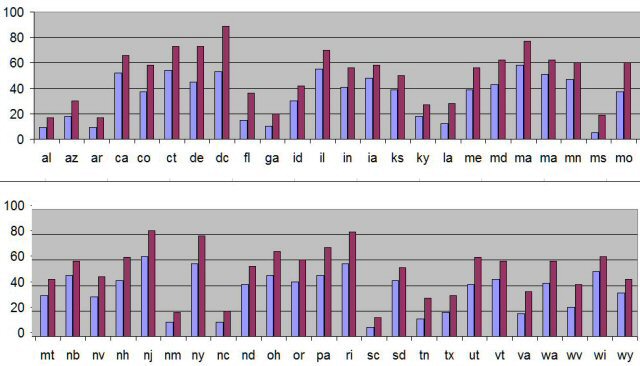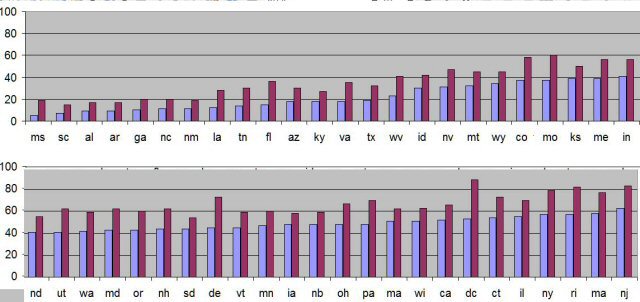Wednesday, June 14, 2017
Another mid-trend chart
Following on this entry about telephones per capita.
Radio Retailing kept track of radios per capita during the '30s. Their comparison of 1930 vs 1935 is another mid-trend reading, providing a good sense of who's ahead and who's behind.
My usual clumsy Excel chart from the list: (XLS here.)
 Left bar is percent of homes with radios in 1930, right bar 1935.
Deep Dixie states started out in the single digits and doubled in those 5 years. (AZ and NM look just like deep Dixie states.) As with phones, DC is way up on top. Unlike phones, the East Coast is dominant, followed closely by everything except Dixie.
Here's the chart after sorting by 1930 percents. The stepped geography shows clearly here.
Left bar is percent of homes with radios in 1930, right bar 1935.
Deep Dixie states started out in the single digits and doubled in those 5 years. (AZ and NM look just like deep Dixie states.) As with phones, DC is way up on top. Unlike phones, the East Coast is dominant, followed closely by everything except Dixie.
Here's the chart after sorting by 1930 percents. The stepped geography shows clearly here.
 Deep Dixie, then Border Dixie, then Mountain, then Midwest, then East. DC didn't dominate in 1930, but jumped in '35 fdr some mysterious reason, which I'll leave fdr the reader to determine.
Economically: Radios were not cheap, ranging from $30 to $1000, just about 1/10 of the price range of cars**. The cheapest radios would cost about two weeks of median income. Not an impulse purchase for a poor family! It's not surprising that Dixie wasn't able to afford radios.
Unfortunately Radio Retailing seems to have stopped its statistics after 1935, which is when the New Deal programs started to kick in.
= = = = =
** Footnote: The cheapest radios of the '30s and the cheapest cars of the '30s were BOTH made by Crosley, who was serious about serving Everyman. Not exactly a valid comparison.... Crosley's cheap radios were proper and complete radios, while his cheap cars were not suitable for family usage.
Deep Dixie, then Border Dixie, then Mountain, then Midwest, then East. DC didn't dominate in 1930, but jumped in '35 fdr some mysterious reason, which I'll leave fdr the reader to determine.
Economically: Radios were not cheap, ranging from $30 to $1000, just about 1/10 of the price range of cars**. The cheapest radios would cost about two weeks of median income. Not an impulse purchase for a poor family! It's not surprising that Dixie wasn't able to afford radios.
Unfortunately Radio Retailing seems to have stopped its statistics after 1935, which is when the New Deal programs started to kick in.
= = = = =
** Footnote: The cheapest radios of the '30s and the cheapest cars of the '30s were BOTH made by Crosley, who was serious about serving Everyman. Not exactly a valid comparison.... Crosley's cheap radios were proper and complete radios, while his cheap cars were not suitable for family usage.
 Left bar is percent of homes with radios in 1930, right bar 1935.
Deep Dixie states started out in the single digits and doubled in those 5 years. (AZ and NM look just like deep Dixie states.) As with phones, DC is way up on top. Unlike phones, the East Coast is dominant, followed closely by everything except Dixie.
Here's the chart after sorting by 1930 percents. The stepped geography shows clearly here.
Left bar is percent of homes with radios in 1930, right bar 1935.
Deep Dixie states started out in the single digits and doubled in those 5 years. (AZ and NM look just like deep Dixie states.) As with phones, DC is way up on top. Unlike phones, the East Coast is dominant, followed closely by everything except Dixie.
Here's the chart after sorting by 1930 percents. The stepped geography shows clearly here.
 Deep Dixie, then Border Dixie, then Mountain, then Midwest, then East. DC didn't dominate in 1930, but jumped in '35 fdr some mysterious reason, which I'll leave fdr the reader to determine.
Economically: Radios were not cheap, ranging from $30 to $1000, just about 1/10 of the price range of cars**. The cheapest radios would cost about two weeks of median income. Not an impulse purchase for a poor family! It's not surprising that Dixie wasn't able to afford radios.
Unfortunately Radio Retailing seems to have stopped its statistics after 1935, which is when the New Deal programs started to kick in.
= = = = =
** Footnote: The cheapest radios of the '30s and the cheapest cars of the '30s were BOTH made by Crosley, who was serious about serving Everyman. Not exactly a valid comparison.... Crosley's cheap radios were proper and complete radios, while his cheap cars were not suitable for family usage.
Deep Dixie, then Border Dixie, then Mountain, then Midwest, then East. DC didn't dominate in 1930, but jumped in '35 fdr some mysterious reason, which I'll leave fdr the reader to determine.
Economically: Radios were not cheap, ranging from $30 to $1000, just about 1/10 of the price range of cars**. The cheapest radios would cost about two weeks of median income. Not an impulse purchase for a poor family! It's not surprising that Dixie wasn't able to afford radios.
Unfortunately Radio Retailing seems to have stopped its statistics after 1935, which is when the New Deal programs started to kick in.
= = = = =
** Footnote: The cheapest radios of the '30s and the cheapest cars of the '30s were BOTH made by Crosley, who was serious about serving Everyman. Not exactly a valid comparison.... Crosley's cheap radios were proper and complete radios, while his cheap cars were not suitable for family usage.
